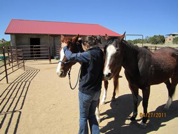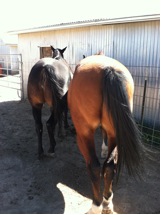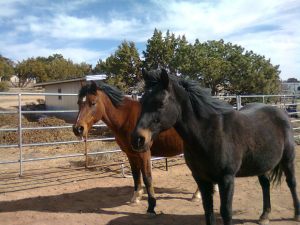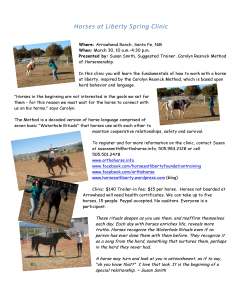Reciprocal movement or “mirroring” – when horses mirror each other’s movement – helps horses help each other in healing and is supportive of the herd as a whole. I use this movement in horse bodywork and it is also used in liberty training – a prerequisite to dancing.
MIRRORING

While practicing Equine Ortho-Bionomy, I am not only aware of the horse I am working with, but also other horses around, and those the horse lives with.
Many times the horse I’m working on is resistant to a certain technique, even though he or she really needs some direct contact.
Horses that live close to one another can benefit from changes I make to one horse. If the first horse is unable to accept a technique, then I will work on the one who is able to accept it.
This has happened recently with several horses who have had restrictions in the neck. They fling their heads and won’t allow me to get to the cervical vertebrae. However, a stablemate is perfectly happy to have her neck worked on, so I go there.
When I go back to the first horse who is restricted the neck has released, the poll is soft. Sometimes that horse is no longer worried about me touching her neck.

The other day my two horses, Zuzka (black) and Khami (bay), were standing side by side. I needed to work on the bay horse, so I began with his spine. As I worked on his spine, the black mare released, which she shows by licking and chewing. His tail is wry, and bent to the right. The black mare has the same restriction but less so. When I worked on his tail, her tail straightened.

They stood with the same leg cocked in rest. When pelvic work in the hips released in the bay horse, the black horse shifted her weight simultaneously and released also – although she doesn’t have hip pain as he does, she has thoracolumbar pain at times.
This is what is called “mirroring,” horses copying and integrating what other horses are doing. They start doing it as soon as they are born and keep doing it all through life. Having stablemates allows them to work this out and take advantage of this beautiful process which supports health.
Essentially what is at work here is herd energy. Herd energy keeps herds healthy, supports and validates the self-corrective process. The proximity and movement help the self-correction process along. In the wild, horses self-correct all the time. You will also find that horses that have spent their lives on pasture do not generally need equine dental work like horses kept in stalls or small corrals do.
Just as you see energy travel through herds when a predator is near, so does energy travel through herds when one is weak, injured or not right in some way. When a predator is near, the lead horse will raise her head, and the others will also raise their heads. Their heightened sense of awareness is key to their survival.
Reciprocal Movement
In working at liberty, we can use this reciprocal movement to support and effect change. Often I will use this natural behavior in horses, and will stand with a horse looking out into the distance at something. I will sometimes ask the horse to engage in a reciprocal movement with me, such as bending into a turn, or companion walking.
I can initiate rolling in the snow (a fair distance from my horse) in order to see if he will roll too. This type of reciprocal movement can lead to a deeper connection that translates to other important work done with your horse.
When companion walking or dancing with your horse using the Carolyn Resnick Method Waterhole Rituals, you are moving together in a fluid dance of companionship, sharing space, linked in a dynamic tempo, even when standing still.
This video of my two geldings by my dear friend Susie Spicer shows a lot of reciprocal movement – running and playing together synchronistically. It also shows play fighting, which they love to do with each other but I don’t let them do it with me!
[youtube=http://youtu.be/ebjL09eknmY]Private sessions and gift certificates are available for bodywork and liberty work, by calling 505.501.2478 or emailing susansmith@orthohorse.info
Click on this flyer to find out about my upcoming Spring Liberty Clinic to be held March 30th in Santa Fe. There are still spaces available.





interesting blog post Susan – thanks – take care and be well